How to Create an Onboarding Webinar for SaaS
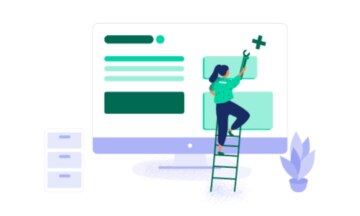
For any SaaS company, onboarding new users is one of the most critical parts of the customer acquisition process. All the work done to attract and convert visitors into users may end up wasted if the onboarding doesn’t properly activate them.
A successful onboarding process will reduce your churn rate and increase your customer lifetime value.
It’s time to scale your demo program. Learn how webinars can help in this on-demand webinar.
From the many options available, one of the most effective ways to onboard new users is through the use of webinars. Webinars educate new users and help them reach the famous “aha moment;” the moment your users realize the value of your software.
In this article, you will learn how to create a successful onboarding webinar for your SaaS business. But before we get to it, let’s see how your webinar SaaS fits into your overall onboarding process.
How to Use Webinar Software in Your Onboarding Process
Webinars are one of the most popular content marketing tactics SaaS companies use to nurture and activate users. But unlike SaaS webinars that focus on closing leads, the development of your onboarding webinar will depend greatly on the role it plays on your onboarding process.
First, you must understand who you are onboarding. If the person you are presenting the SaaS webinar to is the same one who signed up for your product, your webinar will be relatively simple.
But if the stakeholders that sign a contract aren’t the ones who use the product itself, then your webinar’s job will be to “sell” the product. Unlike traditional sales where you want to close a person, your webinar’s goal is to get the user to reach the “aha moment;” the moment when your users perceive the value of your offering.
Once a user reaches this “aha moment,” they are more likely to engage with your tool. This, in turn, will increase the chances they become activated.
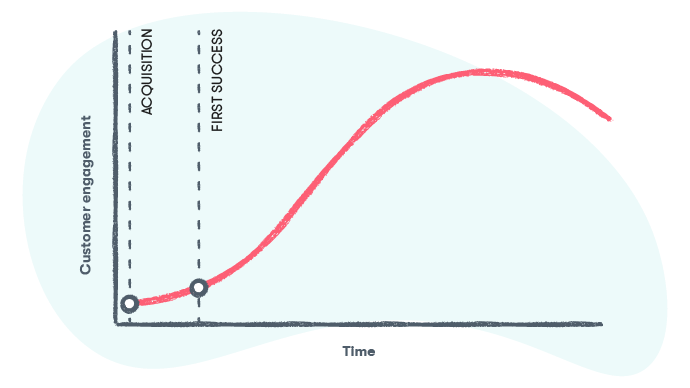
Ruairí Galavan, Senior Manager of Product Education at Intercom, found that those customers who attended webinars were six times more likely to activate than those who didn’t.
What’s more, those who attended their webinars were more likely to activate than those who didn’t attend. For Intercom, it’s not a matter of signing up for a SaaS webinar, but attending and participating in it.
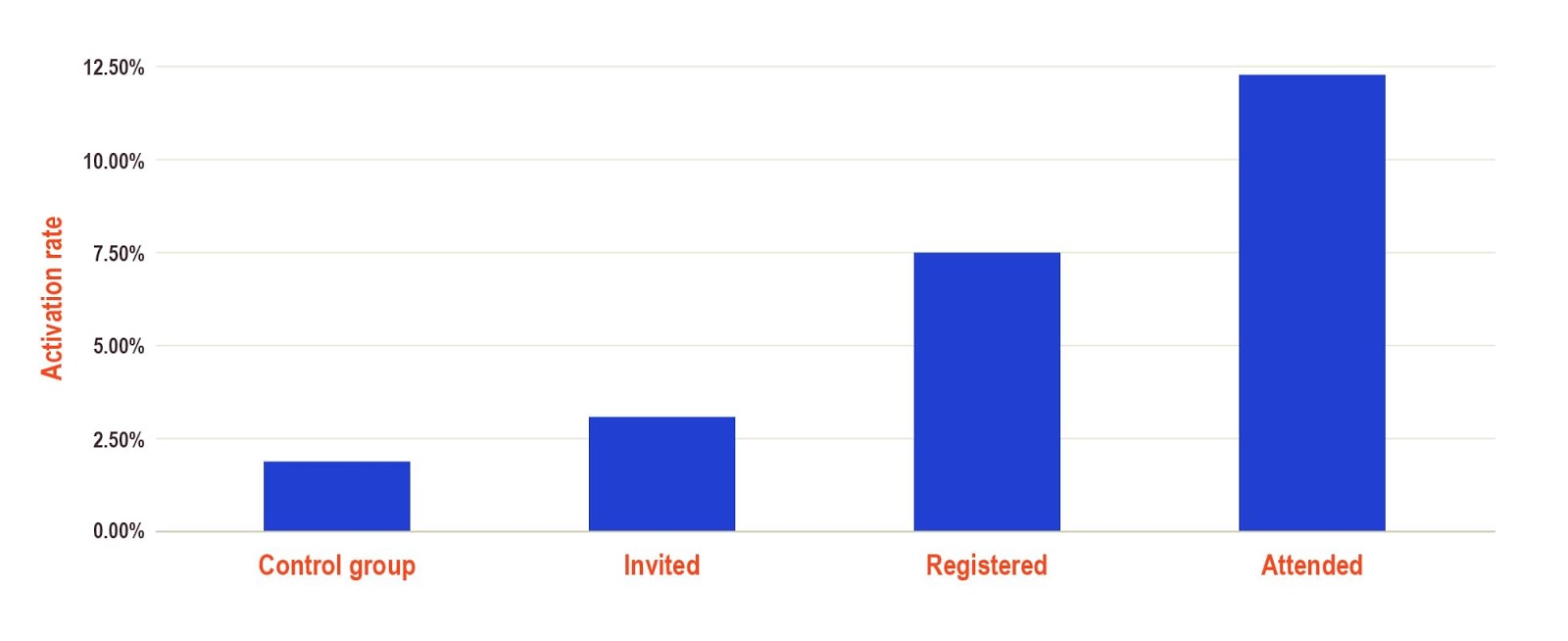
The first question you must ask yourself is not how you can educate your users with a SaaS webinar, but what’s their “aha moment” and the triggers that lead to their activation.
Research your activated users and find what actions they take regularly. Also, look for common characteristics that may explain their behavior. If possible, you could look at the actions your users took before they became activated — this may show the critical triggers that caused their activation.
Alternatively, you can also research your churned users, those who became users but didn’t activate and left. They will also show you the issues they run into and which led them to their exit.
The insights you uncover in research will guide your webinar development.
Based on this user-first approach, your webinar for SaaS won’t be focused on specific features or how your users should use your product.
Your onboarding webinar will be focused on getting your user to reach their “aha moment.” This will lead to higher user engagement and lower churn rates, as Intercom found.
3 Ways to Carry Out a Successful Onboarding Webinar
Align Your Product with Your User’s Goals
The first way you can position your onboarding webinars is as a product tour. This is one of the most common approaches to webinars because guiding new users to your product will ensure a higher activation rate and shorter time-to-value ratio (TTV).
This approach is especially useful if your research found that there is a misalignment between the stakeholders and the users — which is a probable case if your sales cycle is long and complex with multiple stakeholders involved.
The SaaS webinar should make it clear how your product can help the user achieve their top goal by:
- Walking them through key workflows
- Highlight the features with the highest use and value perception
The ultimate goal of this product tour should be to align with the goals that your user has. It’s not a matter of explaining to them every feature and detail secondary to the user’s needs. Instead, your tour must show the way towards the core value; this will make it easier for the user to reach their “aha moment.”
Let’s use the hypothetical example of Grammarly, a writing assistant for writers and editors. The product has many features, including a plagiarism checker and a grammar corrector.

The host — that is, the marketer who runs the SaaS webinar — should not use this webinar to show all these features at once. Instead, they should align their entire presentation to the user’s primary goal, which is to find and fix grammar issues.
No matter how many bells and whistles the tool may have, all the user wants is to improve their writing. By the end of the product tour, the viewer should find themselves knowing how the tool helps them with this specific goal.
One way the host could present this onboarding webinar is by using Grammarly in real-time while editing an incorrect document. All the other features should be ignored.
This user-focused approach will ensure the viewer will have an easier time reaching their “aha moment” thanks to their alignment with the tool’s value.
Incentivize the Right Triggers
A second way to approach onboarding webinars is by highlighting the triggers that correlate with higher activation rates.
It’s critical that your user research finds these specific triggers, so your webinar focuses on the right one. One popular example comes from Twitter, which found that those users who followed at least 30 users had higher chances of activation.
Similarly, you could focus your SaaS webinar on the specific triggers that you know will end up in faster time-to-value (TTV) and activation.
Let’s use another hypothetical example, this time from the project management tool Basecamp. The core value this company brings its users is increased productivity through efficient team collaboration.
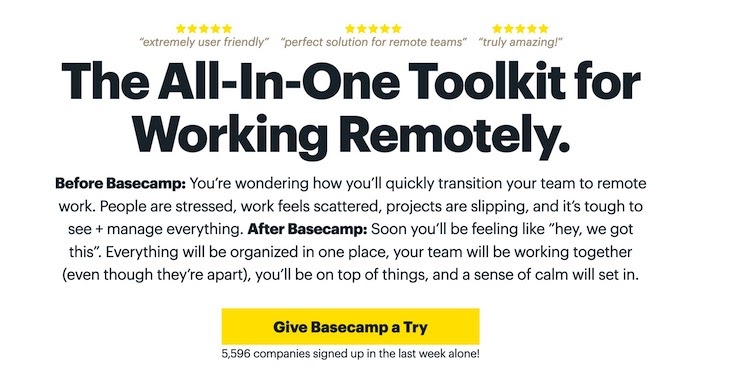
The only way for their users to see this value is by inviting teammates. Without teammates, a user couldn’t collaborate, thus ignoring the real value of the tool. Conversely, by inviting a certain number of teammates, the user would be able to reach their “aha moment” and become activated.
We can assume that if this was the case, their onboarding webinar should emphasize the importance of inviting teammates to the product.
For instance, both at the start and the end of the webinar for SaaS, the marketer could ask every viewer to invite at least three members while on the call (or whatever number they found). Their email marketing automation could also continue to push for this action to happen as long as the user continues to ignore it.
Clarify the Misunderstandings
A final way you can use your onboarding webinars is by clarifying any misunderstandings your users may have in the way your software works. To find these misunderstandings, you first need to know the frictions that arise early in a user’s life.
Once again, this problem may arise if the end-user is not aware of how your product works because they weren’t involved in the sales process. Alternatively, this problem may be caused by a poor performance from your sales and marketing teams who don’t do a good job of explaining the value of your product.
In either case, your onboarding webinar should immediately clarify your software’s capabilities.
Let’s imagine Atlassian’s issue tracking product Jira was creating an onboarding webinar. The user may not be aware that the only way they can extract the value from the tool is by having them create a project and then an issue within it.
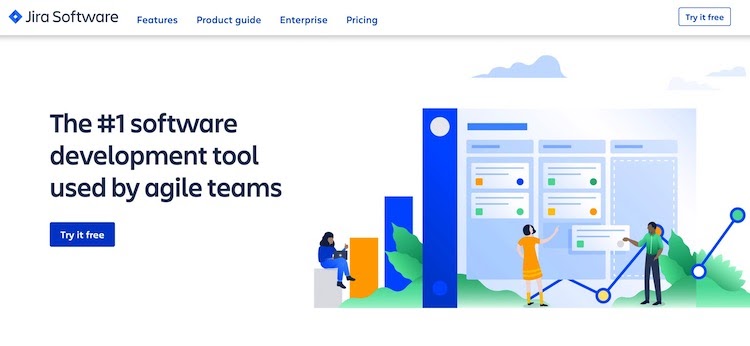
Their onboarding webinar should highlight this key workflow, so by the end of the presentation, Jira’s value can indeed surface and activation rates improve.
Conclusion
Onboarding webinars are an incredibly effective way to decrease churn rates and increase activation rates at the same time. Once you understand the role they play in your onboarding process, you can truly make the most of them.
Any of these three suggestions will help you fulfill their real value as long as you leverage your user research. The insights you take from them will show you the problems you have in your onboarding process and the best option to use.
By focusing on your onboarding process first, your webinars for SaaS will maximize your efforts and increase your activation rates — which it’s what your onboarding process is all about.
Author Bio: Ivan Kreimer is a freelance content writer for hire who creates educational content for SaaS businesses like Leadfeeder and Campaign Monitor. In his pastime, he likes to help people become freelance writers. Besides writing for smart people who read sites like ON24, Ivan has also written in sites like Entrepreneur, MarketingProfs, TheNextWeb, and many other influential websites.